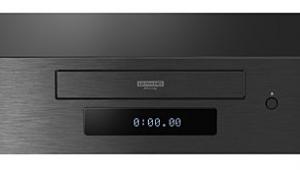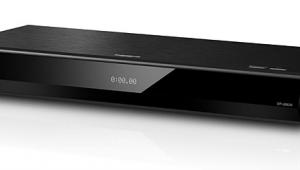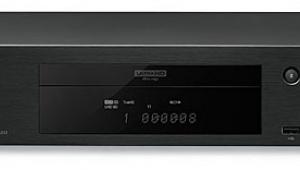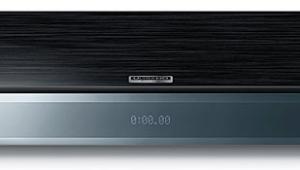Arcam FMJ BDP100 Blu-ray Player Page 2
 The remote that came with our player also failed during my tests. A replacement arrived in time for me to complete the review.
The remote that came with our player also failed during my tests. A replacement arrived in time for me to complete the review.
The System
For this review, I used a JVC DLA-RS1 LCOS projector together with an iScan Duo video processor and, alternately, a 60-inch Pioneer Elite KURO PRO-141FD plasma. I also added a new Sony VPL-VW90ES 3D projector (used in 2D here) to the display mix, although it came in too late for more than a few hours of use. (A full review of the VPL-VW90ES is under way for a future issue.)
I did most of my audio listening in my home theater room (approximately 15.5 by 25 by 8 feet). The speaker setup consisted of my reference floorstanding Energy Veritas v2.8s (left and right), the Revel C12 center and S12 surrounds, and a Hsu Research VTF-15H subwoofer.
The remainder of the system included an Integra DTC-9.8 surround processor, a Parasound Halo A51 5.1-channel amplifier, and 1990s vintage cables from Monster Cable, Cardas, Tara Labs, and Kimber Kable. For my two-channel analog testing, I substituted a Jeff Rowland Design Group Consummate preamp for the Integra surround processor. The Consummate offers repeatable volume steps of 0.1 to 0.2 decibels. It can also memorize different volume settings for different inputs and switch between them on the fly from its remote control. This facilitates nearly instantaneous, level-matched A/B analog comparisons.
Dancing in the Dark
My first sessions with the BDP100 went exceptionally well. The Arcam handled two new movies, The Sorcerer’s Apprentice and Scott Pilgrim vs. the World, without a hiccup. The video quality was outstanding—at least as far as I can discern viewing such unfamiliar material—and ditto for the dynamic audio on both discs.
I also sampled a wide range of familiar two-channel music selections, with the player’s coaxial digital output routed directly to a digital input on the Integra surround processor. While I can’t say that what I heard in this early listening exceeded the sound from other fine Blu-ray players I’ve used—or even some fine CD playback gear—it certainly more than held its own.
In mid-2010, I evaluated seven different 2D Blu-ray players over several installments in my Ultimate AV blog (available at ultimateAVmag.com). As I noted then, modern disc players of reasonable quality are difficult to evaluate in isolation. Head-to-head comparisons can more clearly reveal both the character and degree of their differences. These differences tend to be subtle, as they were here. But they are not irrelevant.

Fortunately, I still had those players on hand. I chose two of them to face off against the Arcam: the Marantz BD7004 and the OPPO BDP-83SE. Both players originally sold for $900 but have now been discontinued in favor of new models (not yet tested here). The Marantz has been selling at heavy discounts and may still be available. It’s a superb player but a slow disc loader.
The OPPO is loaded with useful technical features, including analog audio upgrades from the standard BDP-83. It also offers near state-of-the-art load times—for a Blu-ray player. So it was a given that I should compare the OPPO’s load times against the Arcam’s. Ratatouille took about 35 seconds on the OPPO from drawer close to the start of the Disney promos. The Arcam took almost 52 seconds. I recorded a similar loading time, with nearly the same spread between the players on Baraka. Oddly, both players were within 5 seconds of each other (an average of 1 minute, 52 seconds) from drawer close to the main menu on Avatar (2D, standard version). Despite the near-tie on Avatar, the Arcam can’t compete with the OPPO in overall Blu-ray loading speed. Still, it’s far from the worst, and it’s fine on DVDs and CDs.
Shadows on the Wall
While I’ve been happy with the video performance of Blu-ray players from Marantz, OPPO, and other manufacturers, there was something about the Arcam that made it stand out from the crowd. The image was vivid, highly detailed, and dimensional. Its advantages in these respects over the OPPO and the Marantz weren’t dramatic; neither of those other players did anything obviously wrong. Nevertheless, my first reaction was that they couldn’t quite match the Arcam’s HD video performance.
I gradually became aware of an intermittently edgy quality to the Arcam’s picture on some material. It was subtle, but when I did see it, there was no missing its digital-looking sharpening. Once I’d spotted it, and once I knew what to look for, it was hard to miss the next time it reared its head.
I first suspected that the player was adding subtle edge enhancement. But it was also possible that the Arcam was simply revealing anomalies in the source material that other players obscured. Since the effect varied from source to source, and even from scene to scene within a given source, there was some justification for that conclusion.
- Log in or register to post comments






























































